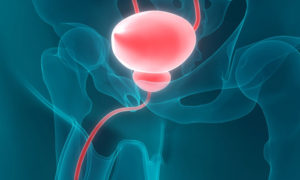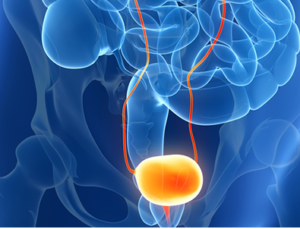Bladder Cancer Tumor Specimens
with matching fresh frozen sera (serum), plasma and peripheral blood mononuclear cells (PBMC) biofluid samples processed from patient’s whole-blood from unique untreated bladder cancer (Urothelial carcinoma) patients.

Bladder Cancer Overview
Bladder cancer begins in the cells of the bladder. The bladder (urinary bladder) is a hollow muscular organ in the lower part of the abdomen that stores urine. Bladder cancer most often begins in the urothelial cells that line the inside of the bladder. Urothelial cells are also found in the kidneys and the tubes or ureters that connect the kidneys to the bladder. Urothelial cancer can occur in the kidneys and ureters, too, but it’s more common in the bladder.
According to the National Institute of Health approximately 60,000 men, 18,000 women per year are diagnosed with the disease. Most bladder cancers are diagnosed at an early stage, when the cancer is highly treatable. But even early-stage bladder cancers can come back after successful treatment. For this reason, people with bladder cancer typically need follow-up tests for years after treatment to look for bladder cancer that recurs.
Bladder cancer signs and symptoms may include, blood in urine (hematuria), which may cause urine to appear bright red or brownish color, though sometimes the urine appears normal and blood is detected in the lab tests, frequent urination, painful urination, back pain.
Bladder cancer begins when cells in the bladder develop changes (mutations) in their DNA. A cell’s DNA contains instructions that tell the cell what to do. The changes tell the cell to multiply rapidly and to go on living when healthy cells would die. The abnormal cells form a tumor that can invade and destroy normal body tissue. In time, the abnormal cells can break away and spread or metastasize through the body.
Types of Bladder Cancer
Following are three types of bladder cancer:
Transitional Cell Carcinoma
Transitional cell carcinoma is the most common type of bladder cancer. It begins in the transitional cells in the inner layer of the bladder. Transitional cells are cells that change shape without becoming damaged when the tissue is stretched.
Squamous cell carcinoma
Squamous cell carcinoma is a rare cancer in the United States. It begins when thin, flat squamous cells form in the bladder after a long-term infection or irritation in the bladder.
Adenocarcinoma
Adenocarcinoma is also a rare cancer in the United States. It begins when glandular cells form in the bladder after long-term bladder irritation and inflammation. Glandular cells are what make up the mucus-secreting glands in the body.

Signs and Symptoms of Bladder Cancer
Most often, bladder cancer is diagnosed after a patient reports blood in the urine, also called hematuria to the doctor.
Patients with bladder cancer may experience the following signs and symptoms:
- Blood or blood clots in the urine
- Pain or burning sensation during urination
- Frequent urination
- Feeling the need to urinate many times throughout the night
- Feeling the need to urinate, but not being able to pass urine
- Lower back pain on 1 side of the body
- Pelvic pain
- Abdominal pain
Causes of Bladder Cancer
The exact cause of bladder cancer is unknown. It occurs when abnormal cells grow and multiply quickly and uncontrollably, and invade other tissues. Certain changes in the DNA inside normal bladder cells can make them grow abnormally and form cancers. Acquired changes in certain genes, such as the TP53 or RB1 tumor suppressor genes and the FGFR and RAS oncogenes, are thought to be important in the development of some bladder cancers.
Smoking is the most important risk factor for bladder cancer. Other risk factors include:
- Having a family history of bladder cancer
- Having certain gene mutations (unusual genetic changes made when your body’s cells are dividing)
- Exposure to too much of certain workplace chemicals used in aluminum production, rubber
industry, leather industry, 4-aminobiphenyl, benzidine such as used in processing paint, dye, metal, and petroleum products can cause bladder cancer. - Taking certain kinds of chemotherapy drugs
- Drinking well water contaminated with arsenic
- Taking the Chinese herb Aristolochia fangchi
- Having chronic urinary tract infections (UTI) including caused by Schistosoma haematobium which causes human schistosomiasis leading to infections.
Bladder Cancer Risk Factors
The following factors may raise a person’s risk of developing bladder cancer:
- Smoking
- Age
- Gender
- Race
- Chemicals
- Chronic Bladder Problems
- Chemotherapy (cyclophosphamide)
- Lynch syndrome
- Arsenic exposure
- Schistosomiasis
Bladder Cancer Diagnosis
Most patients are diagnosed with bladder cancer once they develop symptoms, therefore some patients have more advanced (later stage) disease when the cancer is found. Still, most patients are usually diagnosed with noninvasive bladder cancer.
Most often, bladder cancer is diagnosed after the patient reports about blood in the urine, also called hematuria. “Gross hematuria” means that enough blood is present in the urine that the patient can see it. It is also possible that there are small amounts of blood in the urine that cannot be seen. This is called “microscopic hematuria,” and it can only be found with a urine test.
General urine tests are not used to make a specific diagnosis of bladder cancer because hematuria can be a sign of several other conditions that are not cancer, such as an infections or kidney stones. Specific type of urine test is performed to screen for the presence of cancer cells in the urine.
The following tests may be used to diagnose and learn more about bladder cancer:
- Urine tests
- Cystoscopy
- Biopsy – Transurethral resection of bladder tumor (TURBT)
- Magnetic resonance imaging (MRI)
- Computed tomography (CT or CAT) scan
- Positron emission tomography (PET) or PET-CT scan
- Ultrasound

Bay Biosciences is a global leader in providing researchers with high quality, clinical grade, fully characterized human tissue samples, bio-specimens and human bio-fluid collections from cancer (tumor) tissue, cancer serum, cancer plasma cancer PBMC and human tissue samples from most other therapeutic areas and diseases.
Bay Biosciences maintains and manages it’s own bio-repository, human tissue bank (biobank) consisting of thousands of diseased samples (specimens) and from normal healthy donors available in all formats and types. Our biobank procures and stores fully consented, deidentified and institutional review boards (IRB) approved human tissue samples and matched controls.
All our human human tissue collections, human specimens and human bio-fluids are provided with detailed samples associated patient’s clinical data. This critical patient’s clinical data includes information relating to their past and current disease, treatment history, lifestyle choices, biomarkers and genetic information. Patient’s data is extremely valuable for researchers and is used to help identify new effective treatments (drug discovery & development) in oncology, other therapeutic areas and diseases. This clinical information is critical to demonstrate their impact, monitor the safety of medicines, testing & diagnostics, and generate new knowledge about the causes of disease and illness.
Bay Biosciences banks wide variety of human tissue samples and biological samples including cryogenically preserved -80°C, fresh, fresh frozen tissue samples, tumor tissue samples, FFPE’s, tissue slides, with matching human bio-fluids, whole blood and blood derived products such as serum, plasma and PBMC’s.
Bay Biosciences specializes in collecting and providing human tissue samples according to the researchers specified requirements and customized, tailor made collection protocols. Please contact us anytime to discuss your special research projects and customized human tissue sample requirements.
Bay Biosciences provides human tissue samples (human specimens) from diseased and normal healthy donors; including peripheral whole-blood, amniotic fluid, bronchoalveolar lavage fluid (BAL), sputum, pleural effusion, cerebrospinal fluid (CSF), serum (sera), plasma, peripheral blood mononuclear cells (PBMC’s), saliva, Buffy coat, urine, stool samples, aqueous humor, vitreous humor, kidney stones, renal calculi, nephrolithiasis, urolithiasis and other bodily fluids from most diseases including cancer. We can also procure most human bio-specimens and can do special collections and requests of human samples that are difficult to find. All our human tissue samples are procured through IRB approved clinical protocols and procedures.
In addition to the standard processing protocols Bay Biosciences can also provide human plasma, serum, PBMC bio-fluid samples using custom processing protocols, you can buy donor specific sample collections in higher volumes and specified sample aliquoting from us. Bay Biosciences also provides human samples from normal healthy donors, volunteers, for controls and clinical research, contact us Now.
日本のお客様は、ベイバイオサイエンスジャパンBay Biosciences Japanまたはhttp://baybiosciences-jp.com/contact/までご連絡ください。


